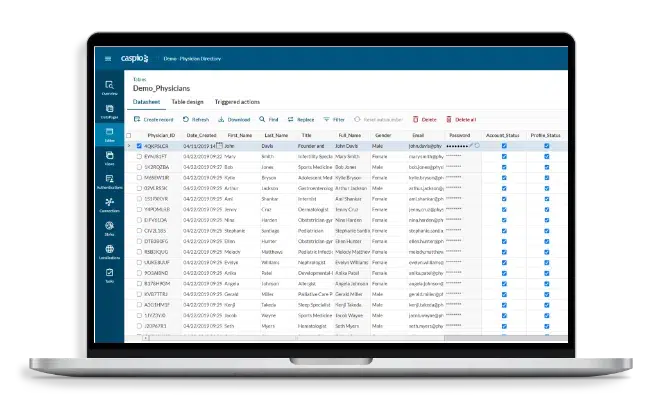Unlock the Power of No-Code for Open Platform Data Source Development
Unlock the Power of No-Code for Open Platform Data Source Development
Blog Article
Discover How Scalable Databases Can Be Utilized Without Coding to Improve Your Service Operations
In today's fast-paced organization atmosphere, the capability to manage and evaluate data successfully is extremely important. no-code. Scalable data sources, particularly when coupled with no-code services, provide a transformative strategy that equips non-technical individuals to improve procedures.
Recognizing Scalable Databases
Scalable data sources are necessary for modern organization operations, enabling organizations to efficiently manage boosting volumes of information without sacrificing performance. These data sources are developed to adapt and expand to the altering demands of a service, ensuring that they can manage bigger datasets and more complex inquiries as business requirements evolve.
Comprehending scalable databases entails recognizing their two main kinds: upright scaling and straight scaling. Vertical scaling, or "scaling up," entails adding more power (CPU, RAM) to an existing web server to boost performance. Alternatively, straight scaling, or "scaling out," requires adding more web servers to distribute the lots, which often causes higher flexibility and mistake tolerance.
One more crucial aspect is the architecture of scalable databases, which can be either non-relational or relational. Relational databases, such as MySQL and PostgreSQL, are structured and use SQL for inquiries, while non-relational databases, like MongoDB and Cassandra, offer even more flexibility with unstructured information.
Eventually, understanding scalable data sources is important for companies aiming to leverage information as a critical property, allowing them to remain affordable in a progressively data-driven setting.

Advantages of No-Code Solutions
Unlocking the capacity of no-code solutions encourages services to simplify operations and improve productivity without the requirement for extensive shows understanding. These platforms enable non-technical customers to create, modify, and manage databases easily, thus democratizing accessibility to modern technology across groups.
One of the key benefits of no-code solutions is their rate of execution. Businesses can promptly release applications and automate procedures, considerably decreasing the time spent on advancement cycles. This agility enables organizations to react without delay to market changes and customer demands, promoting an one-upmanship.
In addition, no-code systems reduce reliance on IT departments for everyday tasks, enabling technical teams to concentrate on even more intricate tasks that require specialized abilities. This shift not just maximizes source allotment but likewise promotes technology within the company.
Cost-effectiveness is one more benefit, as no-code options can decrease growth and maintenance expenses. By lessening the requirement for coding knowledge, business can harness the capacities of their existing labor force without the overhead of hiring extra employees.
Popular No-Code Data Source Tools
The increase of no-code services has actually led to the development of various database devices that deal with businesses looking for performance and access. These tools empower individuals with limited technological knowledge to produce, handle, and manipulate databases flawlessly.

Caspio stands apart for its capacity to develop web applications without any type of coding. It enables services to produce durable databases and deploy applications quickly, catering to various sector demands. Similarly, Flair offers user-friendly interfaces and powerful data monitoring capacities, allowing companies to additional hints develop personalized applications tailored to their operations.

Usage Situations in Business Operations
Just how can organizations utilize data source devices to improve their operations? Scalable data sources give companies with effective capabilities to manage and analyze information without the need for extensive coding expertise. These devices can simplify various company processes, inevitably leading to improved performance and efficiency.
One prominent use situation is client connection management (CRM) Services can utilize scalable data sources to track consumer interactions, preferences, and feedback, making it possible for individualized communication and much better service. By systematizing this info, groups can team up much more effectively and react to consumer demands in real-time.
An additional considerable application is supply management. Companies can utilize no-code data source devices to monitor stock levels, track shipments, and forecast demand. This makes certain optimum inventory levels, reduces waste, and minimizes stockouts.
Additionally, project monitoring can gain from scalable data sources by enabling groups to handle tasks, target dates, and sources in a combined system. With real-time updates and information visualization, project managers can make educated choices.
Starting With Application
Implementing scalable data sources in service operations calls for a structured method to Check This Out make certain successful assimilation and usage. The initial step is to conduct an extensive needs evaluation, recognizing details business requirements, information types, and anticipated development patterns. This foundational understanding will direct the choice of the appropriate database solution.
Following, select an user-friendly, no-code database system that aligns with your functional objectives. no-code. Lots of modern solutions use instinctive interfaces, allowing non-technical customers to handle data efficiently. After choosing a platform, develop a clear information architecture that details exactly how data will certainly be organized, accessed, and preserved
Training is essential; guarantee that staff member are geared up with the needed skills to use the database. Take into consideration providing tutorials or workshops to familiarize team with the system's performances.
Conclusion
In conclusion, the assimilation of official site scalable data sources through no-code remedies provides considerable advantages for business operations. These platforms equip non-technical users to effectively handle and analyze data, helping with boosted decision-making and partnership. By taking on devices such as Airtable and Notion, companies can improve processes and decrease dependancy on IT sources. Eventually, leveraging these innovations can lead to enhanced efficiency and functional efficiency, placing organizations for sustained development in an affordable landscape.
One preferred no-code data source device is Airtable, which incorporates the performance of a spread sheet with the power of a database.Exactly how can businesses utilize data source devices to boost their operations? Companies can utilize scalable databases to track client communications, preferences, and comments, enabling customized interaction and much better solution.Applying scalable databases in service procedures needs a structured approach to make sure effective assimilation and use.In conclusion, the integration of scalable databases via no-code services provides considerable benefits for business operations.
Report this page